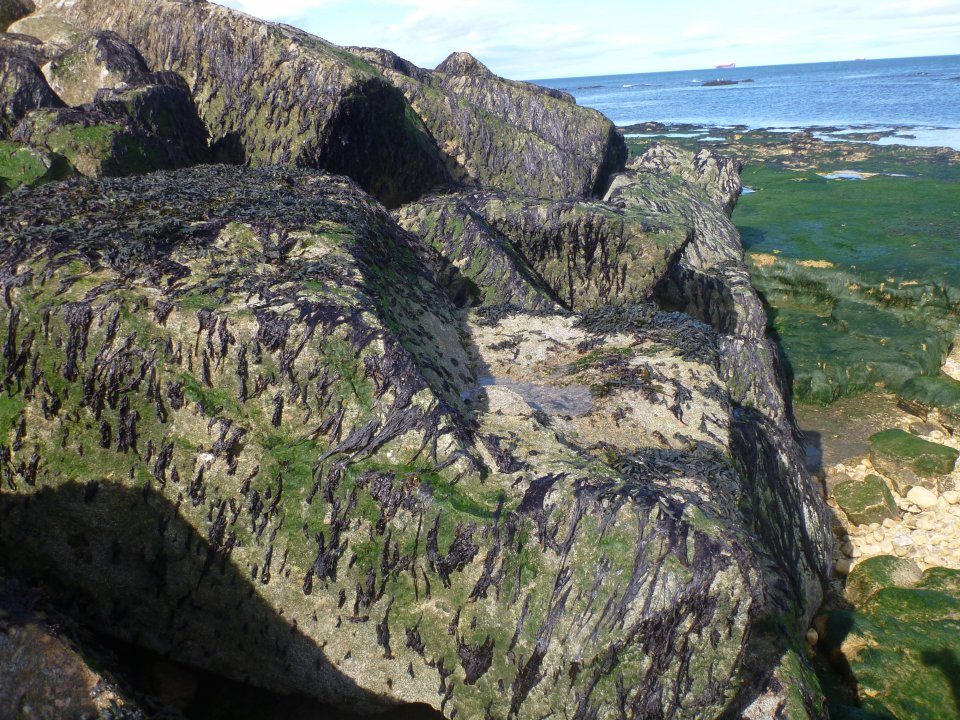
The Headland coastal defences at Hartlepool protect 562 residential and commercial properties, but also protect key heritage features including the Heugh Gun Battery scheduled monument. The defences consist of north-east facing vertical masonry and concrete walls, built over the last 150 years, and are now in poor condition, frequently overtopped during storms, and suffered significant damage during the winter 2013/2014 storms. The previous defences were fronted predominately by a Magnesian limestone intertidal shore platform, with limited areas overlain by perched beach deposits. The uppershore zone (0-10 m from the seawall) displayed considerable evidence of active abrasion with reduced ecology.
Ecological enhancement of hard coastal structures. Project aimed to mitigate expected habitat losses associated with improving coastal defences for both the natural substrate & pre-existing defences within Natural 2000 site, & minimise future habitat losses due to sea level rise & coastal squeeze.
The Scheme aimed to provide a coastal protection Scheme to reduce coastal erosion risk to the community and increase amenity value of the frontage over the next 100 years. Phase 1 included 800m of low level granite rock revetment designed to protect the toe of the most deteriorated sections of existing seawall and prevent damage or undermining of the foundations by dissipating wave energy. However the Scheme also aimed to provide the same ecological function for over wintering birds and as such there will be no overall loss of habitat function for Annex II bird species and other species within the waterbird assemblage.
The Headland foreshore coastal defence scheme at Hartlepool is within the Teesmouth and Cleveland Coast Natura 2000 site, designated under the EU Birds Directive as a Special Protected Area (SPA) for internationally important numbers of waterbirds It is also designated for waterbirds under the Convention on Wetlands of International Importance (Ramsar convention), and a Ramsar site and a Site of Special Scientific Interest (SSSI). Overwintering bird patterns along the Durham coastline show that the area impacted by this Scheme represent some of the most important feeding sites for designated species, an environment also under threat from coastal squeeze under a ‘Hold the Line’ policy . If intertidal invertebrate species on which the birds feed cannot adapt and migrate inland with future sea level rise, then the locally available habitat they depend on will be reduced and/or lost in the future. This will impact negatively on the condition status of the qualifying features.
In order to achieve a habitat outcome that most closely mimics the existing rocky shores at Hartlepool, and which offers feeding opportunities for the qualifying waterbird features, a combination of passive and active multi-scale enhancement was employed. Inexpensive ‘passive’ techniques (e.g. choosing construction materials based on lithology and surface roughness), or more ‘active’ multi-scale enhancements that sought to better mimic the geomorphological heterogeneity of natural rocky shores. This can include applying fine-scale millimetre to centimetre textures to rock and concrete blocks, incorporating sheltered and overhanging areas, and building water-holding features such as pools. The concrete wall casing, created using Reckli formliners (Yukon design) mimic natural rock and provide enhanced mm – up to 27mm scale texture, and improve the structural complexity of the wall compared to plain cast concrete
- Developing climate change adaptation; improving risk management and resilience
- Better protection and restoration of coastal ecosystems
- Flood peak reduction
- Reduce flood risk
- Reducing temperature at meso or micro scale
- Developing climate change mitigation
- Carbon sequestration and storage
- Restoring ecosystems and their functions
- Greater ecological connectivity across urban regenerated sites
- Improve connectivity and functionality of green and blue infrastructures
- Increase achievements of biodiversity targets
- Increase Biodiversity
- Increase quality and quantity of green and blue infrastructures
- Increased cultural richness and biodiversity
- Enhancing sustainable urbanisation
- Changing image of the urban environment
- Creation of green jobs relating to construction & maintenance of NBS
- Increase amount of green open spaces for residents
- Increase awareness of NBS solution & their effectiveness and co benefits
- Increase population & infrastructures protected by NBS
- Increase willingness to invest in NBS
- Sustainable development of coastal regions
at its outset this was the largest and only the fourth known operational ecological enhancement of hard coastal infrastructure in the UK (after Shaldon, Devon, Isle of Wight and Bournemouth). It represents an important ‘proof of concept’ demonstration of how ecological enhancement research and innovation can be operationalised in the UK beyond its research context. Subsequent studies detail appraisals of the rationale, approval process, design criteria and building phase considerations related to meeting the habitat mitigation requirements of the Hartlepool Headland Coastal Defence Scheme.
Cost effective climate change adaptation and ecological mitigation of hard coastal structures for Habitats Directive is possible.
